The best hunting gear for visually impaired outdoorsmen includes the Digital Crosshairs 1000SA targeting system, VIS500 guided aiming devices, adaptive Tinker Triggers, one-way see-through blinds with silent windows, Action Trackchair all-terrain mobility solutions, tactile maps, two-way radios with tactile buttons, specialized optics with large objective lenses, magnetic attachment platforms, and safety harnesses with quick-release features. These adaptive technologies empower you to hunt independently while maintaining safety in the field.
Digital Crosshairs 1000SA: Game-Changing Technology for Low Vision Hunters
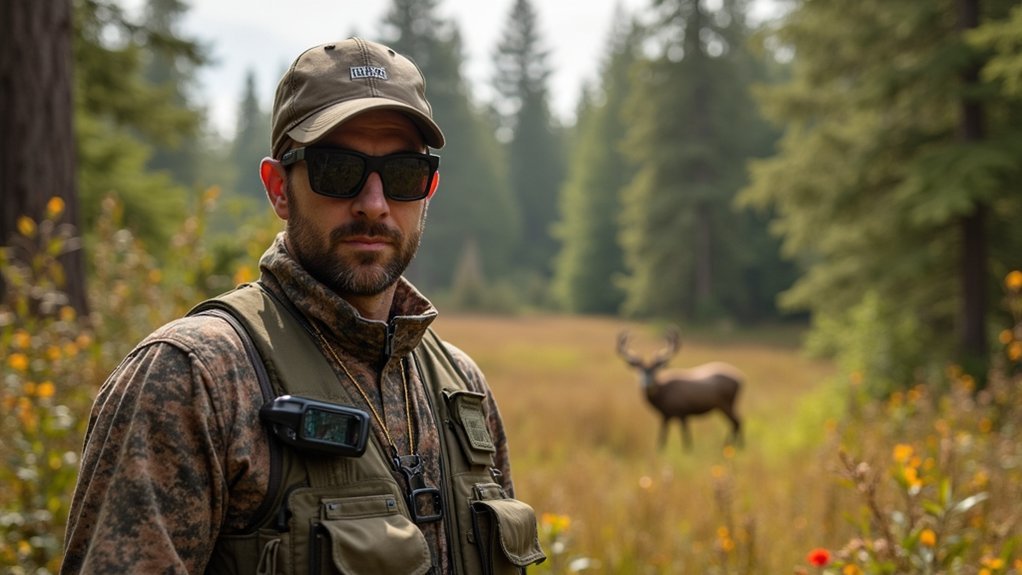
While many hunters with visual impairments have struggled to participate in the sport they love, the Digital Crosshairs 1000SA has revolutionized their hunting experience.
This $700 device converts any standard rifle scope into a digital targeting system with an LCD display, eliminating the need to peer through traditional eyepieces.
The system utilizes SONY IMX225 starlight sensor technology, providing clear imaging in near-darkness conditions. The weather-resistant design handles heavy recoils and remains reliable in various hunting environments.
Experience night hunting redefined with SONY IMX225 starlight sensors delivering crystal-clear visibility in the darkest conditions.
You’ll appreciate the standard 4.3-inch rail-mounted display, with an optional 7-inch screen available for enhanced visibility.
Whether you’re dealing with macular degeneration or total blindness requiring spotter assistance, the flexible mounting options accommodate your needs.
The 12-foot extension cable and goose neck mount allow customized positioning, making this device ideal for hunters with various visual and mobility challenges.
Spotting Systems: The Power of Guided Aiming
Beyond digital displays, guided aiming systems offer another remarkable solution for visually impaired hunters. The VIS500 Aiming Device uses camera sensors and auditory feedback to guide your aim, with pitch and volume adjustments indicating precision. The high-precision device offers accuracy of ±0.25mm at 10-meter distances, making it remarkably reliable for targeting game.
You’ll appreciate how these systems connect via Bluetooth to your headphones, providing real-time guidance as you track targets. The technology includes essential safety features that alert you if humans enter your field of view.
For training purposes, the VIS500 Trainingsoftware lets you visualize aiming lines on a computer screen. The Accessible Aiming Project even integrates multiple targeting modes for various game animals like deer or turkey.
With rechargeable batteries and adjustable settings, these spotting systems make hunting accessible regardless of your visual limitations.
One-Way See-Through Blinds for Enhanced Concealment
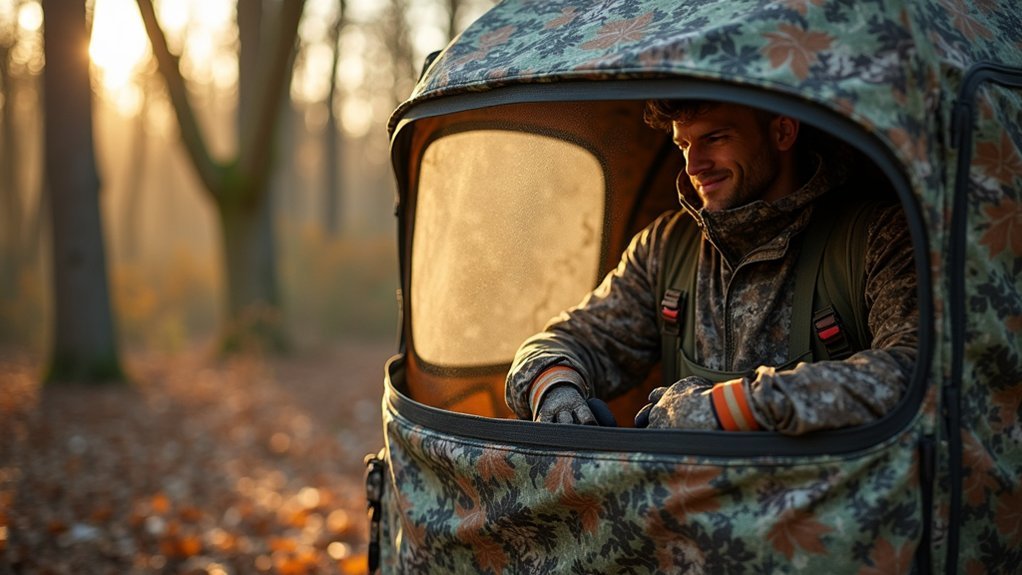
Your blind’s one-way mesh technology provides essential concealment while still allowing you to track movement with remarkable clarity.
Modern see-through blinds feature specialized window systems you can adjust without alerting nearby game.
The silent operation mechanisms in premium models eliminate disruptive noises that would otherwise compromise your hunting position. The roomy interior of these blinds can comfortably accommodate multiple hunters while providing each individual with sufficient space to maneuver their equipment.
Improved Concealment Technology
Although traditional hunting blinds present challenges for visually impaired hunters, one-way see-through blinds have revolutionized the experience with their remarkable visibility benefits. These specialized blinds offer up to 270° panoramic views while keeping you completely concealed from game. Models like the VisMaster 270° provide excellent visibility with their no-trip door design.
| Feature | Benefit | Accessibility Advantage |
|---|---|---|
| One-way mesh | Clear outside visibility | Enhanced light transmission |
| Veil Camo patterns | Terrain matching | Tactile recognition points |
| Silent window sliders | Adjustable viewing | No-look operation |
| Spring-assist doors | Quiet entry/exit | Easy, intuitive access |
The technology’s mesh design allows you to track targets more effectively without detection. For visually impaired hunters, these blinds reduce the need for excess movement while providing better situational awareness. The spacious interiors accommodate assistive devices and companions, making the hunting experience more accessible and enjoyable.
Silent Window Operation
Silent window operation represents a game-changing advancement for visually impaired hunters who rely heavily on sound awareness in the field.
You’ll appreciate the noise-free sliding windows and silent magnetic doors that allow you to adjust your position without alerting nearby game.
These innovative one-way see-through designs provide you with clear visibility while keeping your silhouette hidden from animals. The fabric perforation technology enhances your limited vision while maintaining concealment.
When combined with silent sliding rails, you can make precise adjustments to your shooting windows without creating disturbance. The Vis360 blind includes dual silent rails on all 9 trapezoidal windows, ensuring completely noiseless adjustments perfect for hunters with limited vision.
For hunters with visual impairments, these features aren’t just conveniences—they’re necessities. The ability to move windows silently while maintaining awareness of your surroundings creates a safer, more effective hunting experience that compensates for vision challenges through enhanced auditory stealth.
Adaptive Trigger Systems and Mounting Solutions
You’ll find adaptive trigger systems like the Tinker Trigger essential for maintaining control despite mobility limitations in your hunting setup.
Magnetic attachment platforms offer versatile mounting options for your Digital Crosshairs 1000SA, whether you prefer positioning on your gun, rest, or custom location for ideal viewing.
Sight-free mounting systems incorporate ergonomic adjustments that accommodate your specific physical stance, enhancing your comfort and independence while hunting. The adaptive technology enables blind marksmen to experience the satisfaction of successful shooting without requiring direct eyesight.
Triggered Shooting Controls
For visually impaired hunters, specialized triggered shooting controls represent a critical advancement in accessible outdoor equipment.
These systems integrate sensory feedback through vibration or sound cues, guiding your aim while allowing independent operation once properly aligned with a spotter’s help.
You’ll find adaptive triggers designed with levers and handles that accommodate various physical limitations, often featuring pull-assist mechanisms that reduce required force. The BT100 Mechanical Bite Trigger offers exceptional control with bite activation for hunters with limited upper body mobility.
Most controls mount securely via picatinny rails, providing flexible positioning and universal compatibility across different firearms.
The best systems offer customizable options that integrate seamlessly with other sensory aids while maintaining durability in outdoor conditions.
Safety remains paramount—real-time feedback systems improve accuracy, though regulations typically require a sighted companion.
With continuous technological improvements, these triggered controls are increasingly precise, reliable, and accessible for diverse impairments.
Magnetic Attachment Platforms
Magnetic attachment platforms represent three key advantages for visually impaired hunters: versatility, simplicity, and security.
These platforms allow you to quickly deploy and adjust your equipment without struggling with complex fasteners or permanent mounts.
You’ll find these systems particularly valuable in various hunting environments. In tree stands, they securely hold your binoculars or cameras, while in ground blinds, they stabilize gear and attach camouflage silently.
The magnetic design enables easier setup and adjustment compared to traditional mounting solutions.
When selecting a platform, consider both adjustable and portable options that offer flexibility during your hunt. The Universal Box Blind Magnetic Curtain Kit at $109.99 provides an excellent foundation for organizing your adaptive equipment.
Always verify the weight capacity and surface compatibility before attaching equipment.
With proper training, these systems integrate seamlessly with adaptive triggers, providing you with both accessibility and safety while maintaining compliance with local hunting regulations.
Sight-Free Mounting Systems
While traditional hunting equipment relies heavily on visual alignment, sight-free mounting systems provide revolutionary options for visually impaired outdoorsmen through specialized adaptive triggers and versatile mounting solutions.
These adaptive trigger systems offer one-handed operation with adjustable lengths to accommodate various shooting positions. They provide essential tactile feedback for aiming and often attach universally to weapons via standard Picatinny rails.
Complementary mounting solutions feature digital displays positioned for superior visibility with flexible attachment options for guns or rests. They’re engineered for balanced weight distribution to enhance stability while incorporating vital safety features.
When paired with technology like Digital Crosshairs 1000SA, these systems allow a sighted companion to assist with aiming through camera displays. This technology has successfully helped thousands regain passion for hunting activities they thought were no longer accessible to them.
This combination of adaptive equipment not only increases accessibility but also preserves your independence and confidence in the field, despite regulatory challenges in some regions.
All-Terrain Mobility Options for Field Navigation
Maneuvering rough terrain presents unique challenges for visually impaired hunters, making specialized mobility equipment vital for field success. Action Trackchair models (ST16-ST22) provide exceptional all-terrain capabilities, handling diverse landscapes with stability and control.
For easier navigation, consider GPS devices with audio feedback that provide voice-guided directions while tactile maps help you understand terrain features. Beacons and trail markers can designate safe paths, while trekking poles offer additional stability on uneven ground. The innovative Digital Crosshairs 1000A complements these navigation tools by enabling effective targeting without requiring users to focus through traditional scope eyepieces.
Modified ATVs with reinforced seats and specialized controls accommodate specific visual needs, while accessible hunting blinds with wide doorways guarantee comfortable concealment.
Always maintain a safety plan with reliable communication devices like satellite phones or two-way radios when venturing into remote areas.
Specialized Optics and Adjustable Scopes for Low Vision
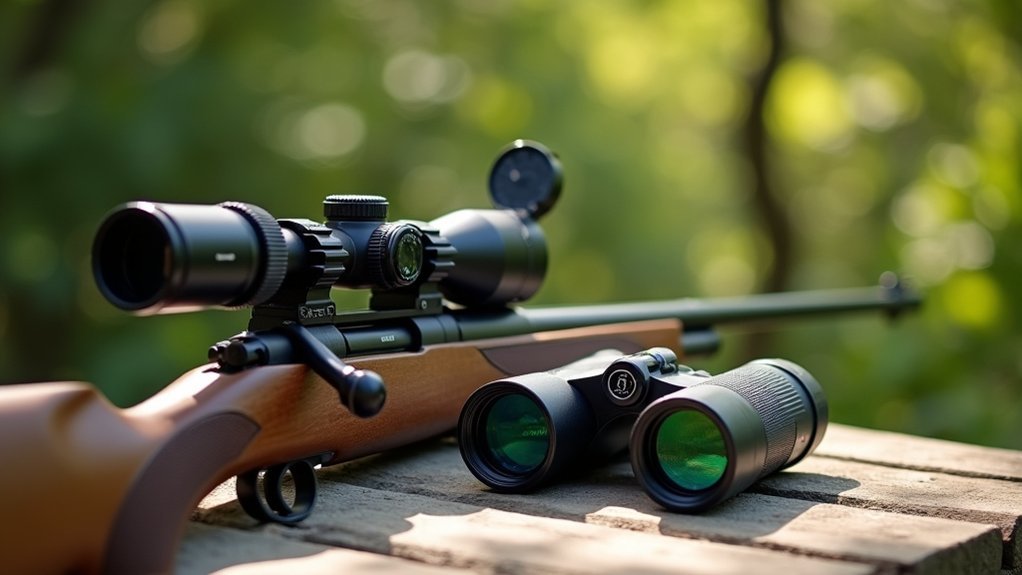
Vision limitations needn’t end your hunting adventures thanks to revolutionary adaptive optics technology. Digital Crosshairs 1000SA and similar LCD display systems provide a game-like targeting interface that can be mounted on rifles, crossbows, or pistols.
These adaptive rifle scopes feature large objective lenses to improve light intake and adjustable brightness and contrast settings to match your visual needs. The remarkable technology includes a 12-foot extension for positioning the display in the most convenient location for each hunter’s specific needs. You’ll appreciate the clear glass and easily manipulated focus knobs that enhance visibility in various conditions.
The displays can be rail-mounted or positioned flexibly, accommodating both visual and mobility challenges. For hunters with specific conditions like macular degeneration, diabetic retinopathy, or glaucoma, these scopes offer independence through their digital enhancement capabilities and user-friendly interfaces similar to smartphone technology.
Communication Tools for Hunter-Spotter Coordination
Successful hunting for visually impaired outdoorsmen often depends on effective coordination with a sighted spotter.
You’ll need reliable communication systems that work in various field conditions.
Consider two-way radios with tactile buttons for instant verbal coordination. Vibrating alert devices offer silent communication when noise might spook game. Digital systems like wireless-connected displays allow your spotter to see exactly what you’re seeing through your scope.
For low-vision hunters, high-contrast visual displays mounted at comfortable viewing angles considerably improve target acquisition. AAC devices with tactile elements provide additional communication options when verbal cues aren’t practical.
Always establish clear emergency protocols and conduct pre-shot safety checks with your spotter. Regular practice sessions will help refine your communication strategy, ensuring you’re perfectly synchronized when that trophy buck appears.
Safety Harnesses and Emergency Response Equipment
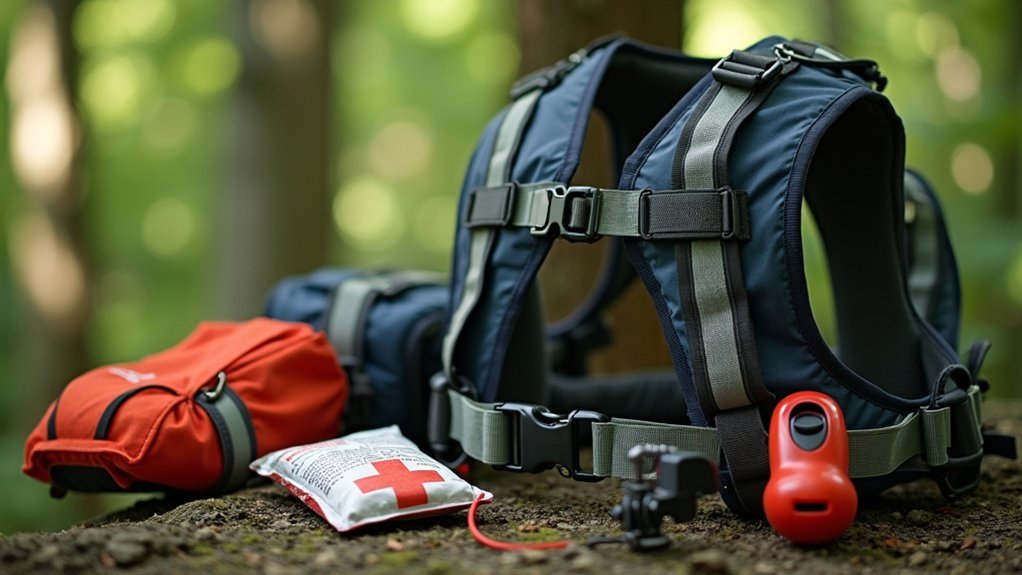
When climbing into a tree stand, you’ll need a secure harness system with easy-to-identify tactile markings for proper setup despite visual limitations.
Quick-release safety features on harnesses like the Q-Safe Tree Strap allow you to detach rapidly if you become entangled or need to descend in an emergency. The Q-Safe’s spring-loaded design provides visually impaired hunters with a self-adjusting mechanism that securely grips trees of any size without the hassle of managing traditional knots.
Location alert devices, including emergency whistles and harnesses with built-in alarms, provide vital assistance should you need to signal your hunting partner or rescue personnel.
Secure Mounting Systems
Safety in the wilderness becomes even more critical for visually impaired hunters traversing elevated positions.
Modern treestand harnesses feature reinforced stitching and abrasion-resistant webbing designed to withstand harsh outdoor conditions while providing reliable protection.
TreeStalker and similar models offer user-friendly fastening mechanisms specifically engineered for individuals with sensory challenges, making mounting and unmounting considerably easier.
The adjustable tether lengths let you customize your range of movement while maintaining constant connection to safety points.
For enhanced safety during low-light conditions or emergencies, the Remote Beacon Illuminator provides critical visibility at an affordable price point of $49.99, down from its original $119.99.
- Heavy-duty buckles tested for high load endurance
- Tether systems that minimize falling risk during climbing
- Reinforced stitching that withstands continuous outdoor use
- Customizable connection points that balance mobility with safety
You’ll find these secure mounting systems provide confidence and independence while ensuring maximum protection during your hunting adventures.
Quick-Release Safety Features
Quick-release mechanisms transform standard safety gear into lifesaving tools for visually impaired hunters.
These harnesses feature one-hand carabiner clips that allow you to detach quickly if needed, while tactile indicators help with proper equipment identification by touch alone.
Look for harnesses with padded nylon construction that distributes weight evenly across your body. The lightweight design of most modern safety harnesses, weighing around 1.9 lbs, makes them comfortable for all-day wear without causing fatigue.
You’ll appreciate the 360-degree movement capability from flexible tethers while remaining secure.
The best models include suspension relief straps for emergencies and adjustable buckles that guarantee a proper fit.
When selecting safety equipment, prioritize models with integrated sensory feedback like vibration alerts that can notify you of potential issues.
These systems typically support up to 300 pounds and often include convenient features like built-in binocular straps and multiple gear pockets.
Location Alert Devices
Everyone who ventures into the wilderness needs reliable safety equipment, but for visually impaired hunters, location alert devices become essential lifelines.
Modern GPS systems with integrated alert features guarantee you’ll never lose your bearings while tracking game or returning to camp. These devices provide accurate navigation in challenging wilderness areas where visibility is already limited for everyone.
Your safety harness should include:
- Built-in SOS button that transmits precise coordinates to emergency responders
- Fall detection technology that automatically alerts your contacts if you’re immobilized
- Dual communication capabilities that work with both cellular and satellite networks for reliable coverage
- Weather-resistant construction with extended battery life for multi-day excursions
Don’t forget to pair your device with smartphone apps that allow friends and family to monitor your location in real-time.
Always carry a traditional paper map as a foolproof backup.
Accessible Storage and Transportation Solutions

Three essential factors make specialized storage and transportation critical for visually impaired hunters: accessibility, organization, and independence. You’ll benefit from durable, customizable storage solutions that incorporate tactile identifiers for easy gear recognition.
Consider modular, lightweight storage systems with tactile labels that you can arrange consistently. These solutions maintain your concealment while keeping equipment readily accessible.
For transportation, elevated blinds with accessible platforms provide both advantage and safety, while ATVs with adaptive controls help navigate challenging terrain.
In camp, organize your layout with clear pathways and consistent gear placement. Carpeted interiors reduce noise, while proper labeling using braille or tactile markers enhances accessibility. The Hanging Double Shelf from hunting blind shelves offers optimal stability while keeping essential gear within easy reach.
With strategic storage solutions, you’ll maintain efficiency in the field despite visual limitations.
State Resources and Training Programs for Visually Impaired Hunters
Maneuvering the hunting landscape with a visual impairment becomes considerably easier when you’re aware of the extensive state resources and specialized training programs available across the country.
Many states offer disability services specifically for visually impaired hunters, including adaptive equipment loans, special hunting permits, and dedicated guide services. The Hunter College School of Education offers comprehensive Orientation and Mobility training that can be particularly valuable for navigating outdoor environments.
- State Accessibility Grants – Apply for outdoor access funding through your state’s wildlife department to cover costs of specialized hunting equipment
- NRA Adaptive Hunting Programs – Enroll in courses tailored specifically to teach hunting skills to visually impaired sportsmen
- Volunteer Guide Networks – Connect with experienced hunters who volunteer to assist visually impaired outdoorsmen during hunts
- State-Specific Accommodations – Check with agencies like Texas Parks and Wildlife or Wisconsin DNR for their disability-focused hunting programs
Frequently Asked Questions
How Do Insurance Companies Handle Adaptive Hunting Equipment Claims?
Insurance companies process adaptive hunting equipment claims similar to regular claims, but you’ll need to document the adaptive nature of your gear. They may require special appraisals due to the equipment’s specialized modifications and higher value.
Can Service Animals Be Trained Specifically for Hunting Assistance?
Yes, you can train service animals specifically for hunting assistance. They’ll help with retrieving game, maneuvering through terrain, tracking prey, and responding to emergencies, all while adapting to your unique hunting environment needs.
What Clothing Features Best Support Visually Impaired Hunters?
You’ll benefit most from clothing with tactile identifiers, Braille labels, noise-reducing materials, and high-contrast designs. Look for adjustable features, breathable fabrics, and smart wearables that provide sensory feedback when hunting.
How Do Weather Conditions Affect Digital Aiming Technologies?
Weather conditions impact your digital aiming tech considerably. Temperature and humidity alter bullet trajectory, while wind affects accuracy. Your devices with ballistic calculators can adjust for these variables, improving your long-range precision.
Are There Hunting Competitions Specifically for Visually Impaired Participants?
You’ll find few competitions exclusively for visually impaired hunters, but many mainstream shooting events welcome you with adaptive equipment. World Shooting Para Sport governs competitions where you can participate using specialized scopes and assistive technology.
In Summary
You’re not limited by vision challenges when it comes to enjoying the outdoors. With today’s adaptive hunting gear and technology, you’ve got options that weren’t available just years ago. Remember to check your state’s resources for specialized training programs, connect with other visually impaired hunters, and always prioritize safety. The right equipment doesn’t just make hunting possible—it makes it enjoyable and successful.

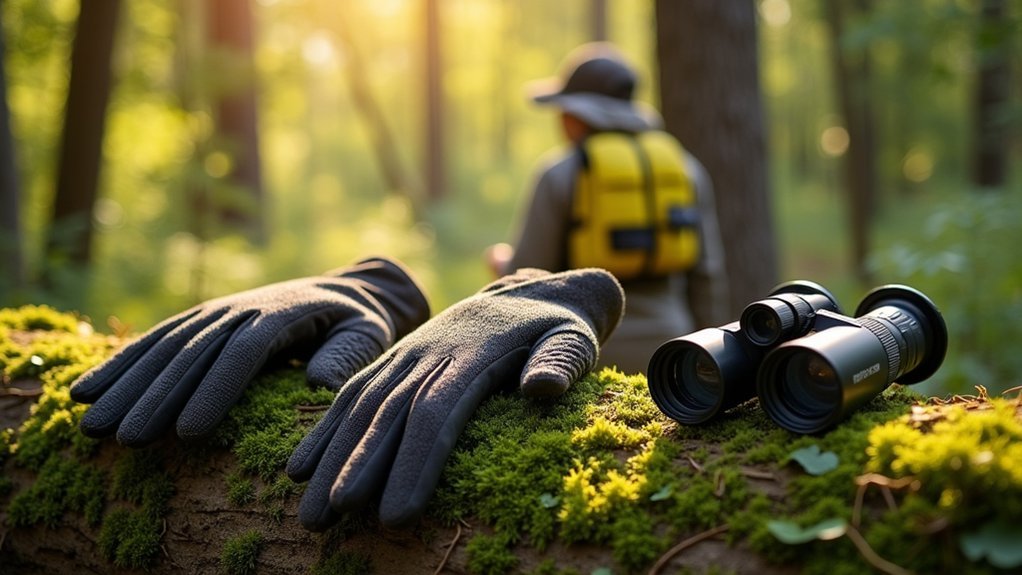



Leave a Reply